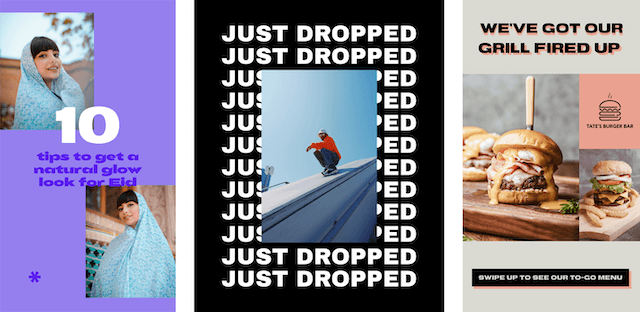When it comes to running your own businesses, we all want to look like a pro – even if we’re learning and winging it as we go. While a site with beautiful design may help your brand stand out online using apps like GoDaddy Studio, it’s also important to make sure the words you use in your content are professional too. That’s why avoiding common grammar mistakes can make all the difference when it comes to making a good impression online.

When it comes to grammar, one thing to note is that rules can change. Language is an ever-evolving beast and the rise of digital marketing has led to a more lax style of communication. It’s common to see beautiful adverts with less formality these days. But this doesn’t mean it should be littered with typos and rookie errors.
An image like this can create a negative impression on your brand. At worst, it can cause a potential customer to move on to someone else’s offering. They’ll likely search for a brand that appears more professional and trustworthy.
With this in mind, here’s a quick guide to common errors you seriously don’t want to make.

1. Greengrocer’s apostrophe
One of the most common grammar mistakes in marketing communications is using the apostrophe incorrectly. This is especially true when it comes to confusing the possessive case with the plural use.
In other words, use an apostrophe after an “s” to indicate an object that belongs to someone. If you’re simply writing a plural, don’t use one at all.
- T’s & C’s should be Ts & Cs [The exception is when writing I’s and A’s as it can cause confusion with “as” and “is” without the apostrophe.]
- Half price avocado’s should be Half price avocados
Now comes the confusing bit – if you’re trying to indicate possession on a plural, the apostrophe goes after the s:
- The avocados’ expiry date is in a month
- The stores’ opening hours differ between locations
2. There is only one of your company — you are unique!
Whether you’re referring to your own company or someone else’s, the use of the word should be singular. A company is a single entity, even though it’s often made up of multiple people.
For example, don’t say:
- Captain Cookies are offering a winter discount.
Rather say:
- Captain Cookies is offering a winter discount to all our followers.
It’s simple grammar mistakes like these that are often overlooked but are worth avoiding to help you sound more confident and refined in tone.
3. Inconsistent headings: Sentence vs. title case
Do you tend to capitalize the first letter of each word in your headings? If so, you’re most likely using a style that’s referred to as title case. This style has more of a proper or polished format and is a popular choice among many publishers today.
If this is the style you’re choosing as a company, it’s best to include it in a formalized style guide to maintain consistency with your team. Make sure to include notes on whether you’d like smaller words like “and” or “for” to be capitalized or not – since both ways are equally acceptable.
Alternatively, a more common practice in digital writing is to write things in sentence casing. This means only the first letter of a word within your heading is capitalized, along with any other pronouns.
Many marketers prefer this style because it’s:
- Easier for people to read
- Less formal
- More conversational
Whatever option you choose, keep things consistent and try not to suddenly insert random capital letters in your copy. You don’t want it to be too jarring for readers.

4. Acronyms and jargon
That handy acronym you use in Slack or emails to your coworkers is fine in that context, but not when it comes to your brand communications.
Writing for an external audience means you’ll need to keep the consumer in mind.
Your audience probably won’t understand that piece of jargon you’re referring to and they may even find it annoying to read! You don’t want to miss out on potential sales from grammar mistakes like these. So be sure to remove unnecessary or lesser-known acronyms from your communications.
When possible, you might also try to use a simple or shorter word instead of a more complex one. Just make sure you’re not using abbreviations or slang to an audience that won’t recognize them.
5. Hyphenated adjectives
Hyphens are typically used to connect two words that describe something, such as:
- Two-pronged approach
- Multi-layered business
However, if one of the words is an adverb ending in “-ly,” you shouldn’t use a hyphen, for example:
- Dimly lit room
- Smartly dressed man
It’s the smaller details that count here, so make sure to comb your posts with a sharp eye to avoid smaller grammar mistakes like these.
6. Split infinitives
A split infinitive is when you split an infinitive verb (e.g., “to run”) with an adverb, which is grammatically incorrect. Always keep the verb compound together, for example:
- To quickly run should be to run quickly
- To suddenly go should be to go suddenly
- To finally decide should be to decide finally
See how much easier that is to read? It’s important to spend some time editing out these types of grammar mistakes before posting.

7. Ending sentences with a preposition
When looking out for grammar mistakes, you want to make sure to avoid prepositions. The correct rule for prepositions is to not end a sentence with a word like “to,” “of,” “on” or “with.”
For example, avoid writing things like:
- Which option are you going to go with?
- Where are you off to?
While we often end with prepositions in daily speech, it’s considered informal and something most people do without even thinking about it. The examples above may sound perfectly acceptable to say out loud, but they technically end in prepositions.
When drafting your company style guide, consider the tone of your brand. A chatty or informal brand could accommodate it into their style guide, but it’s always best to be aware of your audience.
Additionally, you’ll want to take into account the form you are writing for. A more formal annual report may not be the best fit, but it could work for copy in an Instagram caption.
8. Inconsistent punctuation
When creating lines of text for your ads, make sure your punctuation is consistent. For example, a flyer header that contains a period in the middle of a line should also end the sentence with a typical sentence structure.
Here’s an example of what to avoid:
- Nourish your body. Calm your mind
You’ll notice there’s one period used in the middle, but nothing at the end. The example above should’ve ended with a period after “mind” to maintain consistency.
9. Dangling participles
This error is appropriately named since it means the modifier is left “dangling” without a word to modify. In other words, it refers to a sentence that includes an ambiguous adjective. This is because it’s not immediately clear who or what it’s referring to.
For example, take a look at the following sentence:
- Having just finished my dessert, the waitress offered to bring me the bill.
Do you see how it could be taken to mean that the waitress ate your dessert? You can fix this by changing the sentence to clarify who finished the dessert. Simply add the intended noun or pronoun (which would be “I” in this case) after the comma.
The sentence should now read:
- Having just finished my dessert, I noticed the waitress offering to bring me the bill.
Dangling participles are grammar mistakes that can seem tricky in the beginning, but can easily be fixed once you understand how they work.
10. Comma splicing
A comma splice is when you use a comma incorrectly. This happens when someone inserts a comma between two sentences that can stand independently on their own.
For example:
- Sam was early for yoga, he waited outside.
A comma is not strong enough to link these two clauses together, so you could fix this by adding a conjunction:
- Sam was early for yoga, so he waited outside.
Alternatively, you could replace the comma with a semicolon or simply keep them as two separate sentences. This choice is not a huge offense from a copywriting perspective, but you’ll look more like a pro if you don’t do it.

Don’t forget to double-check your work
Making sure your grammar is correct can create a sense of professionalism — especially when building trust and credibility with your audience. But don’t worry if it takes you some time.
English can be a challenging language to master and there are many exceptions to traditional rules.
When in doubt, always double-check that you’re writing a sentence correctly by doing a bit of online research. Make sure to use credible language sources, rather than just relying on built-in spelling or grammar checkers.